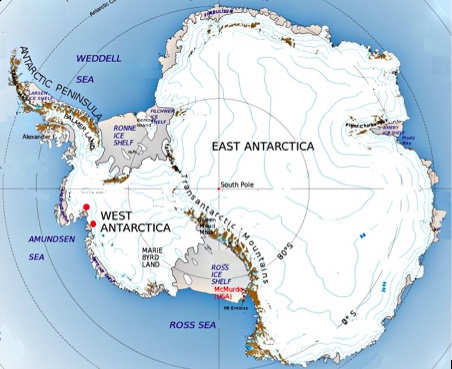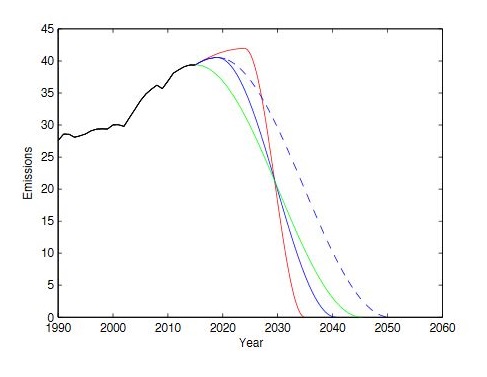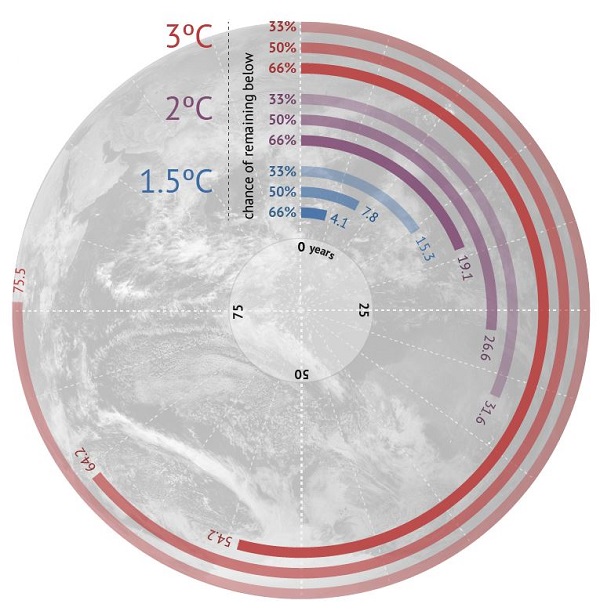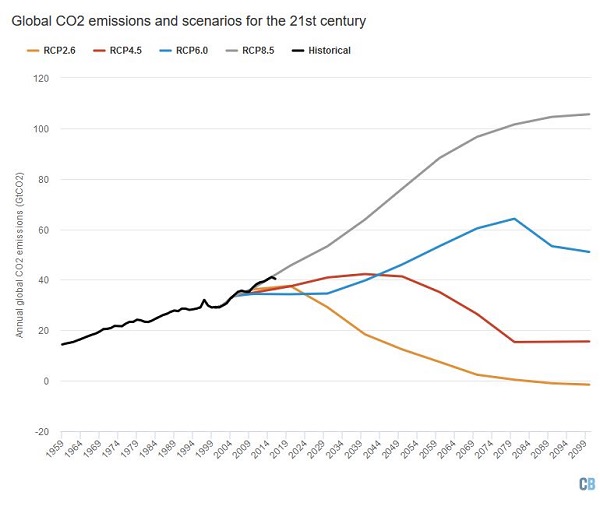1. Antarctic ice melt may have tipped
David Spratt at Climate Code Red has a post surveying recent studies on Antarctic ice sheet melting. I’ll cut to the chase with his update of a recent report from NOAA:
- a revised worst-case sea-level rise scenario of 2.5 metres by 2100, 5.5 metres by 2150 and 9.7 metres by 2200. It says sea level science has “advanced significantly over the last few years, especially (for) land-based ice sheets in Greenland and Antarctica under global warming”, and hence the “correspondingly larger range of possible 21st century rise in sea level than previously thought”.
The order of business is the ice in the Amundsen Sea area becomes compromised, leading to the decay of the West Antarctic ice sheet, which could yield 3-5 metres of SLR within two centuries.
Mechanisms similar to those causing deglaciation in West Antarctica are now also found in the giant ice sheet of East Antarctica, which could yield a further 5 metres by 2200.
Then there is Greenland, and that is without increasing our current 400ppm or so of CO2 concentrations. Here’s the map:

Melting in the Antarctic Peninsula and Larsen B are just a pipe-opener.
The questions now are how much, how soon, and how much could be prevented even if we reduce CO2 levels by sucking it out of the air?
2. Biodiesel from sugarcane
- Led by the University of Illinois, a multi-institution team created varieties of sugarcane that have much more oil in their leaves and stem than unmodified varieties. That oil could be used in biodiesel production. It was assumed that this boost in oil production would result in less sugar production, although that turned out not to be the case. That’s a good thing, as that sugar can be used to produce ethanol.
It can be grown on marginal land that wouldn’t be suitable for food crops.
- So far, the team has created sugarcane plants that are 13 percent oil, 8 percent of which is the type that could be made into biodiesel. Even if that figure were just 5 percent, the researchers claim that it would amount to “an extra 123 gallons [466 l] of biodiesel per acre than soybeans and 350 more gallons [1,325 l] of ethanol per acre than corn.”
They are hoping to boost oil to 20 percent, which is the theoretical maximum limit.
3. Clive Hamilton talks about why he resigned from the CCA
Clive Hamilton talked to Graham Readfearn about why he resigned from the Climate Change Authority. In the end he was disgusted with Turnbull’s advocacy for ‘clean coal’.
- “It’s a tragedy to watch a man like Malcolm Turnbull to shrink into the kind of shell of a person that he has become…”
He also said that with the new appointees to the CCA in 2015 came a secret plan to work towards an emissions intensity scheme. That came unstuck when Josh Frydenberg floated the idea and Turnbull immediately killed it off. He says:
- “The Liberal party has undergone a transformation in the last 10 years and it’s now dominated federally by troglodytes from the hard right – the anti-science brigade, some of whom probably cheered when Pauline Hanson attacked vaccinations the other day. These are the anti-science, anti-expertise crowd — the kind of people who now advise Donald Trump.”
Climate deniers have been energised by the election of Trump.
Hamilton is publishing a new book on climate change. He is no longer hopeful:
- “If you look at what the scientists are saying and you’re not despairing then you are not really listening to what they are saying.”
4. Climate action: what we must do by 2020
The Paris agreement does not come into effect by 2020. Christiana Figueres, former UNFCCC Executive Secretary, has launched a plan as to what we must do now to bend the emissions curve downwards by 2020. The report, 2020: the Climate Turning Point, was authored by scientists from a number of bodies, including Carbon Tracker, Climate Analytics and the Potsdam Institute for Climate Impact Research.
It calls for 30% global renewables by 2020, 25% of new vehicle sales to be zero emissions electric vehicles by 2020, and of course no new coal mines. And it says that investment in clean technologies needs to be increased to at least $1 trillion each year by 2020, up from $300 billion now.
This graph shows alternative scenarios:

The coloured lines assume a remaining budget of 600 GtCO2, with the dashed line 800. The green line peaks in 2016.
5. Carbon countdown
Carbon Brief has a useful post Analysis: Just four years left of the 1.5C carbon budget which has a clever diagram:

I don’t like the assumption that a 66% chance is OK, or at least the best we can do under the circumstances. That assumption would be present in the 2020 Turning Point report above also.
Moreover, I think their assumption that current emissions are at 39 Gtpa is also wrong. The Stern report a decade ago had emissions at 42 Gtpa when you count them all, not just the ones from fossil fuels.
They also give the following graph, which show emissions largely tracking business as usual, but falling away slightly from about 2014:

You often read that emissions have flatlined in the past couple of years. The only problem is that at Mauna Loa, where they measure what is actually in the air, the increases are still increasing.
6. Climate change factsheets
The Climate Council has issued factsheets on the impact of climate change on tropical cyclones and on intense rainfall and flooding. They seem be faithful to the science.
Currently the atmosphere can carry 7% more water than previously. I don’t think that means that in all cases rainfall intensity increase will be limited to 7% over past experience, however. Then they say this:
- For Queensland and New South Wales, the two states most badly affected by ex-Tropical Cyclone Debbie, extreme rainfall events are likely to worsen. For example, maximum one-day rainfall is expected to increase by up to 17 and 18% for New South Wales and Queensland respectively, by the end of the century for a high emissions scenario, relative to 1986-2005 climate (CSIRO and BoM 2015).
7. Cairns seminars
Geoff Henderson has sent me a note about the weekly seminars hosted by James Cook University’s Tropical Environmental and Sustainability Sciences unit in Cairns each Wednesday at 4pm. He says they last about an hour and you get a beer and nibbles after.
He says the speakers are always good and the seminar is videoed live to Townsville campus. The talks are available at the above link.
I noticed one on April 5 on the expansion of the tropics.


This is a new Climate Clippings in case you missed it. I guess publishing in the afternoon of Good Friday is not prime time, but it was done and I wanted to move on.
I think that James Cook University is showing the way forward. Ignore the politicians, act to make their decisions irrelevent. Government has only a partial impact on Climate Action. The kind of decisions they make on energy operate at the grid level where progress is being made regardless of the greed driven deniers. Abbott removed the Carbon Pricing mechanism but the next Labour government can put it back on but next round not um and are about it for seven years. Progress will be made in the Roger Jones way, in steps as circumstances allow.
Meanwhile distributed energy production continues to increase, and soon with a substantial battery system (either Tesla or RedFlow Z-Cell,…or any other newcomer) households will be motivated to become optionally independent from the grid. That very capability is the one lever the public has to bring rationality into the energy industry.
The full suite of technologies to resolve our high Energy Dependence in a sustainable manner without loss of life style are still being developed, but are close to being serviceable. It is going to take some more time but sustainability will win out simply because it is better and cheaper in the long run.
https://onestepoffthegrid.com.au/redflow-launches-10kwh-zcell-into-australian-home-battery-storage-market/
Having now looked again at the zcell it looks like being the way to go. I’ve just done a block model of it to see if it fits in my yacht design, and it looks achievable so I am going to talk to them to see if it will take the motion of the boat. If so it then becomes an ideal yacht power base load supply. Boats these days are highly dependent on solar power which they harvest both with PV and Wind. Fresh Water desalinators are no very common on boats with many models that will run from battery power. Then there are the computers and laptops, one at least per crew member plus the boats computers for system management, navigation, and the autopilot. So the zcell looks like an ideal off grid system component. Yacht hot water generation is still a partially resolved component for me, still working on the best approach.
It might seem a bit odd talking yachts in conjunction with land energy solutions, but a yacht is a closed system that must work reliably under harsh conditions for long periods so is an ideal test bed for of grid sustainability solutions.
…that was “not umming and ahhring about it”
I’d be very interested in your findings Bilb.
I’m looking into a houseboat design rather than a yacht.
A houseboat that can be off grid liveable on dry land for most of the year, then transportable to launch for varying periods on water.
Hinchinbrook Channel or any protected water.
That sounds like a great plan, Jumpy.
A catamaran fits that cluster of needs apart from the transport aspect. You would have to be more specific about the circumstances (road distance and type). They have quite awesomely spacious interiors and there are many available at low second hand prices.
Apart from the Delos crew I am following Distant Shores (Sheryl and Paul Shard) who have just sold their Southerly 49 and are having a new design done specifically around their experiences and needs. The Southerly yachts (now no longer trading) were special for being shallow draft (30 inches) which made so many extra options possible for exploring inland waterways and shallow coastal waters.
If it is a traditional houseboat that you want then all you need is a steel tub made for you and you being a chippy can build the rest, house style.
As far as the energy systems are concerned, yes, stay tuned, I will be spending some serious money down this path during the next 18 months.
BilB
Would contemporary, standard solar hot water panels mess up the aerodynamics/dynamics of the yacht? Anyone yet making squashy* ones that can bend like a half inflated air bed?
* apologies for technical jargon
Don’t worry too much about political parties dominated by anti-science mumbo-jumbo men. Like so many other institutions in today’s society, they have lost a lot of the power they once had; that is now held by other decision-makers with real power. All the wheelers-and-dealers in the mainstream parties can do nowadays is be good little boys and do as they are told.
The anti-science mentality? That’s a self-correcting problem; anyone who argues with the physical laws of the universe – and their consequences – ALWAYS comes off second-best; it is only when it happens that differs from one case to another.
On a boat you want a hot water system where radiation from the sun gets to the water you are heating but it is hard for heat to be conducted back to the surface of the heater which will often be exposed to cold winds and spray. (Conventional solar heaters do this and ones based on vacuum tubes should do it better.) You would also want to store the hot water low in the boat for stability reasons. implies a water pump driven by solar power.
Alternatively, you could simply use solar power to drive a heat pump.
Ambigulous,
There are a few things there. It is becoming routine now for cruising yachts to have a solar panel supporting frame over the davits to hold up to 4 solar panels. The area is small relative to the boat and the sails. JohnD is largely right about the collector types, but that does depend a lot on where the boat cruises. Below are a couple of articles I found to use while considering the options.
One of the most important issues is to do with the collector medium. rather than losing heat, a far bigger problem for solar collectors is collecting too much energy and producing steam. Further, for a boat the other issue is wasting heat once collected. With these criteria in mind, the solar PVT’s that I have done some design work on use a flourine based heat exchange oil to collect the energy and store in a separate tank. ideally the oil would be above 120C thereby reducing the volume of heat storage medium required. Also heat above 110C can be used for absorptive refrigeration for both air conditioning and freezer boxes.
As to the collectors the Apricus system looks as efficient as possible unless the external reflector is added. But…my preference is to integrate the collector with the solar panels, there will be losses but the collector area is the greatest it can be within the very finite space.
http://www.yourhome.gov.au/energy/hot-water-service
http://spf.ch/fileadmin/daten/publ/procheat.pdf
Bilb: If you are talking about storing heat on a boat you might think about using phase change materials to reduce the weight of heat storage.
Yes, I have thought of it in the past JohnD, but do not have any in depth knowledge.
Just looking at it now, and I welcome correction, it seems that the latent heat of liquefaction is not startling. But for a storage temperature of 170C using 40 Kg of Erythritol (a sugar apparently with a melting point around 120C) would store around 3.8 Kwhrs from the phase change and another 2.1 Kwhrs for the 50 C rise to 170C.
To heat 40Kg almond oil through the working temperature range from 40C (shower temp) to 170C from what I can see on google 23.4kJ/Kg (.0065Kwhr) stores around 33.8 Kwhrs.
My original plan for heat management on the boat was to heat a small quantity of oil to 200C and then heat water via a heat exchanger. I found an interesting flourine based inert oil which was good to 300C. In that context the potential contribution from a phase change medium was fairly minor.
Does that argument stack up, John?
Phase change is important for refrigeration with the ammonia absorptive cycle, I believe, and the Erythritol is ideal for that.
In a boat space is important so with that constraint how would you specify a compact heat energy storage system?
I hasten to add, JohnD, I don’t know whether any of those figures are correct.
I found a cross reference for the oil energy content
http://www.dgfett.de/material/physikalische_eigenschaften.pdf
Sunflower oil 2,500 J/g at 175C gives 100,000kJ for 40 Kg which is 27.8 kWhr, and in the ball park of the other figure.
By comparison it takes 6.9 kWhr to heat 200 litres from 40C (shower temp) to 70C (max cylinder temp). So if my calc is correct then a small 40 Kg cylinder of very hot oil is the energy equivalent of an 800 litre household water cylinder. It is also quite dangerous, I do realise so I was thinking along the lines of the evacuated stainless steel multi skin thermal containers and a very small heat exchange device.
Bilb: I looked at phase change materials when I wrote an article for REnewEconomy but lack practical experience. At the time my interest was allowing Air conditioners to store heat/cool to remove power consumption peaks. I tended to ignore organic phase change materials and favor hydrated salt mixes because of fire safety considerations. If you look at this link and look at positive temperature salt mixtures there are clearly some products that would suit hot water storage.
Molten salts are resisting an easy energy capacity comparison, JohnD, so I will have to research them more thoroughly after topping up my chemistry knowledge. A key aspect of this area is that you need to find a Eutectic material that works within the process temperature range. Molten salts appear to operate well above 200C, but I know that there is a wide variety of compositions and properties.
Your link above needs attention, John.
I advise that everyone reads the Methane Threat article here..
http://arctic-news.blogspot.com.au/
…very carefully, and go to some effort to understand what is being said.
It looks very much like an environmental dam has burst and the long projected flood of methane from the Arctic Sea floor methyl hydrates is beginning to flow. This very rapid Climate Flip has happened in the past each time with devastating consequences. Over 12 years ago I took a Scientific American article on this very Climate Threat personally to my local Federal MP who was at the time the chief government whip to John Howard and discussed the nature of the methane threat with him, so as this unfolds the Australian governemnt cannot say that they were not alerted to the danger.
This is catastrophy. For anyone under 40, you can forget about your superannuation, you will never get to collect it.
BilB, if you follow that link there is another one on the RHS to Warning of mass extinction of species, including humans, within one decade.
I’d have to say I’ve never seen anything quite so alarming. Must take a closer look.
Jumpy: Good plan – but although Hinchinbrook Channel looks attractive, with high mountain ranges on either side, seacraft in the Port Hinchinbrook resort copped a beating a few cyclones back, and that whole waterway is alive with 4-Metre-long + + hungry scalies.
Brian and BilB: Can’t access those links just yet (our interwebs here is a touch rusty). Was wondering where the Morlocks came from in Wells’ novel, The Time Machine. Looks like they might have descended from the early 21st Century humans who went straight underground before the Climate Flip wiped out almost all the rest.
Good advice about superannuation though – and I suggest adding funeral insurance too.